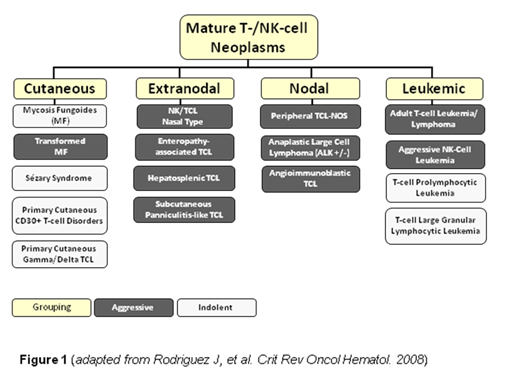Subcutaneous T-cell lymphoma
| Subcutaneous T-cell lymphoma | |
|---|---|
| Specialty | Oncology, cutaneous oncology |
| Complications | HPS (hemophagocytic syndrome) |
| Diagnostic method | Requires biopsy confirmation by expert hemopathologist |
| Differential diagnosis | Lupus panniculitis, cutaneous gamma delta T Cell lymphoma |
Subcutaneous T-cell lymphoma (also known as a "panniculitis-like T-cell lymphoma") is a cutaneous condition that most commonly presents in young adults, and is characterized by subcutaneous nodules.[1]: 739 Common symptoms include fever, fatigue, and pancytopenia.
Diagnosis
Classification
Subcutaneous panniculitis-like T-cell lymphoma is a subtype of
Subcutaneous panniculitis-like T-cell lymphoma is a rare type of lymphoma that infiltrates the subcutaneous fat but does not involve the skin. There are two subtypes – alpha-beta and gamma-delta. Patients with the gamma-delta subtype have a more aggressive clinical course.[3]
It is described as
Treatment
Historically, subcutaneous panniculitis-like T-cell lymphoma, as with other types of T-cell lymphoma, was treated similarly to B-cell lymphomas. However, in recent years, scientists have developed techniques to better recognize the different types of lymphomas, such as PTCL. It is now understood that PTCL behaves differently from B-cell lymphomas and therapies are being developed that specifically target these types of lymphoma. Currently, however, there are no drugs approved by the
Novel approaches to the treatment of PTCL in the relapsed or refractory setting are under investigation.CHOP or CHOP-like regimens have been used.[13]
Research
Pralatrexate is one compound currently under investigation to add to the frontline treatment of PTCL. It is currently approved by the FDA for relapsed or refractory T cell lymphoma. Side effects include mouth sores, which can be severe.[citation needed]
See also
- Cutaneous T-cell lymphoma
- Lennert lymphoma
- Skin lesion
References
- ISBN 978-0-7216-2921-6.
- ^ Swerdlow SH, WHO Classification of Tumours of Haematopoietic and Lymphoid Tissues, 2008
- PMID 18954748.
- PMID 18708940.
- PMID 19029417.
- PMID 18303032.
- PMID 17598836.
- PMID 16871285.
- ^ d’Amore F, et al. Blood. 2006;108:A401
- PMID 12011124.
- PMID 10929023.
- PMID 10944137.
- PMID 17454599.

